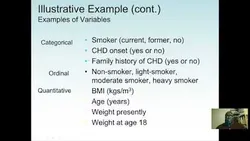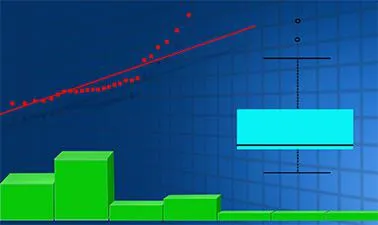
Biostatistics: Math Computer Science Programming 
Biostatistics is a field of study that focuses on the measurement, study design, frequency distribution, and analysis of data. It is used to understand the relationships between different variables and to make predictions about future outcomes. This course covers topics such as mean, median, and mode, as well as stem and leaf plots. It provides students with the skills to analyze data and draw meaningful conclusions. ▼
ADVERTISEMENT
Course Feature
![]() Cost:
Cost:
Free
![]() Provider:
Provider:
Youtube
![]() Certificate:
Certificate:
Paid Certification
![]() Language:
Language:
English
![]() Start Date:
Start Date:
On-Demand
Course Overview
❗The content presented here is sourced directly from Youtube platform. For comprehensive course details, including enrollment information, simply click on the 'Go to class' link on our website.
Updated in [February 21st, 2023]
What does this course tell?
(Please note that the following overview content is from the original platform)
Measurements - Biostatistics (Unit 1 Lecture).
Study Designs - Biostatistics Lecture 2 Part 2.
Frequency Distribution and StemPlot (Stem and leaf plot) - Biostatistics Lecture Unit 3.
Mean Median Mode -- Biostatistics I.
Introduction to Probability - Biostatistics Lecture 5.
Binomial Probability Distribution - Biostatistics.
Continuous Random Variable, Continuous Distribution and Normal Probability Distribution.
Introduction to Statistical Inference, Sampling Behavior of a Mean, Count and Proportion.
Hypothesis Testing, Null and Alternative Hypotheses, Test Statistic, P-Value, Significance Level.
Confidence Intervals and Estimation, Confidence Interval for μ when σ is known - Biostatistics.
Correlation and Regression, Hypothesis Testing using Correlation and Regression - Biostatistics.
Biostatistics - Multiple Linear Regression.
t Distribution Test: Inference About a Mean - Biostatistics.
t test to compare two Independent Means, Inference About the Mean Difference - Biostatistics.
One-Way ANOVA: Comparing Several Means - Analysis of Variance - Biostatistics.
Introduction to Nonparametric Tests - Kruskal-Wallis test - Biostatistics.
Inference About a Proportion: Analysis categorical variables - Nonparametric Tests: Biostatistics.
We consider the value of this course from multiple aspects, and finally summarize it for you from three aspects: personal skills, career development, and further study:
(Kindly be aware that our content is optimized by AI tools while also undergoing moderation carefully from our editorial staff.)
This course provides an introduction to biostatistics, covering topics such as measurements, study designs, frequency distributions, mean, median, mode, probability, binomial probability distribution, continuous random variable, normal probability distribution, statistical inference, hypothesis testing, confidence intervals, correlation and regression, multiple linear regression, t-distribution test, t-test to compare two independent means, one-way ANOVA, and nonparametric tests.
Possible Development Paths:
Learners of this course can develop their skills in biostatistics and use them to pursue a career in data science, health informatics, epidemiology, public health, or research. They can also use their knowledge to pursue a degree in biostatistics, mathematics, computer science, or programming.
Learning Suggestions:
Learners should supplement their learning with additional courses in mathematics, computer science, and programming. They should also practice their skills by working on real-world data sets and projects. Additionally, they should read up on the latest developments in biostatistics and stay up to date with the latest trends in the field.
[Applications]
Upon completion of this course, students should be able to apply the concepts of biostatistics to their own research projects. They should be able to use the various measurements, study designs, frequency distributions, and stemplots to analyze data. They should also be able to use the concepts of probability, binomial probability distribution, continuous random variables, and normal probability distribution to interpret data. Additionally, students should be able to use the concepts of statistical inference, hypothesis testing, confidence intervals, correlation and regression, multiple linear regression, t-distribution tests, t-tests to compare two independent means, one-way ANOVA, and nonparametric tests to draw conclusions from their data.
[Career Paths]
1. Biostatistician: Biostatisticians use mathematics, computer science, and programming to analyze data and develop models to help inform decisions in the medical and health fields. They are responsible for designing and conducting studies, analyzing data, and interpreting results. The demand for biostatisticians is growing as the need for data-driven decisions increases.
2. Data Scientist: Data scientists use mathematics, computer science, and programming to analyze large datasets and develop models to help inform decisions in a variety of industries. They are responsible for collecting, cleaning, and analyzing data, developing predictive models, and interpreting results. The demand for data scientists is growing as the need for data-driven decisions increases.
3. Research Analyst: Research analysts use mathematics, computer science, and programming to analyze data and develop models to help inform decisions in a variety of industries. They are responsible for collecting, cleaning, and analyzing data, developing predictive models, and interpreting results. The demand for research analysts is growing as the need for data-driven decisions increases.
4. Clinical Research Coordinator: Clinical research coordinators use mathematics, computer science, and programming to analyze data and develop models to help inform decisions in the medical and health fields. They are responsible for designing and conducting studies, analyzing data, and interpreting results. The demand for clinical research coordinators is growing as the need for data-driven decisions increases.
Course Provider

Provider Youtube's Stats at AZClass
Over 100+ Best Educational YouTube Channels in 2023.
Best educational YouTube channels for college students, including Crash Course, Khan Academy, etc.
AZ Class hope that this free Youtube course can help your Biostatistics skills no matter in career or in further education. Even if you are only slightly interested, you can take Biostatistics: Math Computer Science Programming course with confidence!
Discussion and Reviews
0.0 (Based on 0 reviews)
Explore Similar Online Courses

C# 10 Reflection

UI & UX Web Design using Adobe XD - User Experience Design

Python for Informatics: Exploring Information

Social Network Analysis

Introduction to Systematic Review and Meta-Analysis

The Analytics Edge

DCO042 - Python For Informatics

Causal Diagrams: Draw Your Assumptions Before Your Conclusions

Whole genome sequencing of bacterial genomes - tools and applications

Doing Clinical Research: Biostatistics with the Wolfram Language

Introduction to Applied Biostatistics: Statistics for Medical Research


Start your review of Biostatistics: Math Computer Science Programming